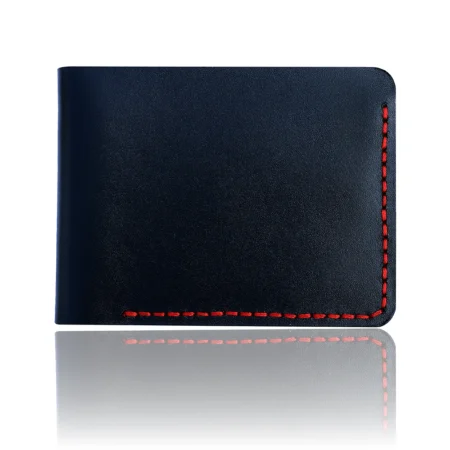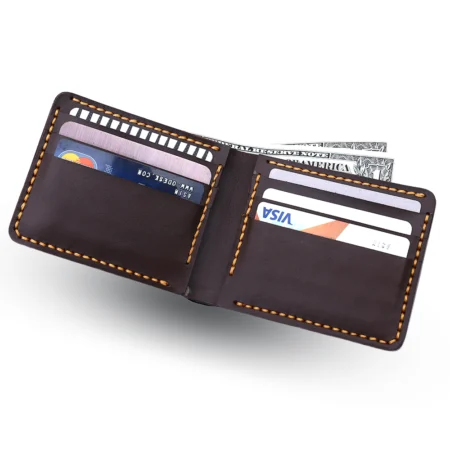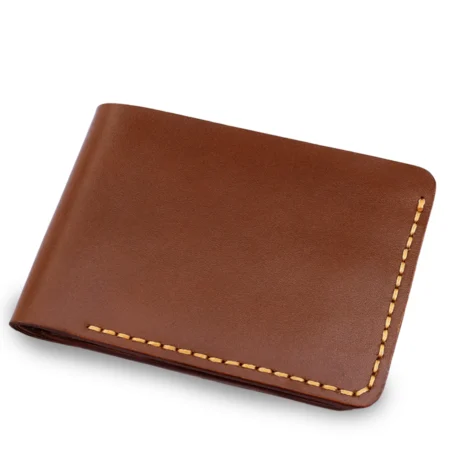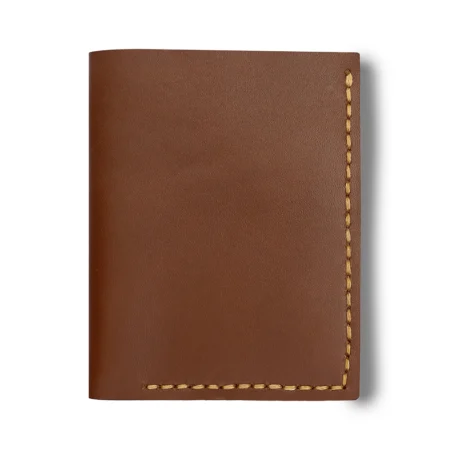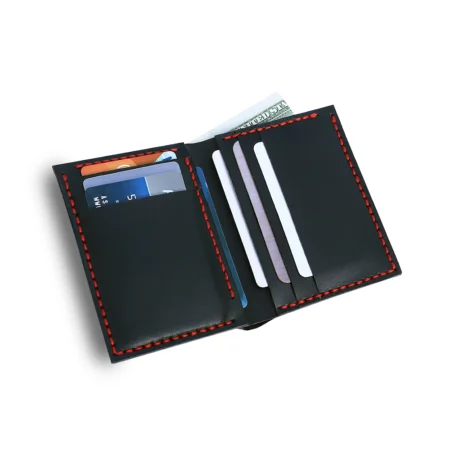How long does a wallet last? Complete Guide
Have you ever thought about how long a wallet truly lasts? It’s a subjective topic—some people replace their leather wallets as soon as they lose shape, while others hold onto them until they’re torn, and the stitching collapses. Despite these varying perspectives, it’s safe to say that a high-quality full grain leather wallet, with proper care, can last up to ten years on average. In contrast, wallets made from standard leather typically have a lifespan of around 2 to 3 years.
In this blog post, we’ll uncover the key factors that influence a wallet’s lifespan, share practical tips to prolong its life, and help you recognise the signs that it’s time for a replacement. Plus, we’ll walk you through the best options to consider when choosing a new wallet to match your needs and style.
Key Factors That Affect Wallet Lifespan
Not all wallets are created equal when it comes to lifespan. Some can be used for decades, while others wear out surprisingly fast. Ever wondered why that happens? The answer lies in several key factors, ranging from the materials used to how you care for your wallet in your daily routine. Let’s dive into the elements that play a crucial role in determining how long your wallet can truly last.
Material
The material of your wallet is the most critical factor in determining its longevity. Leather wallets, particularly those crafted from full-grain leather, ensure exceptional durability and can last a decade or more with proper care. However, it’s essential to understand the different types of leather to make an informed choice.
Don’t confuse “real leather” with PU or vegan leather, as these are synthetic materials and lack the durability and elegance of genuine leather. While these alternatives might look appealing initially, but they wear out much faster.
For a wallet that truly stands the test of time, opt for premium materials like full-grain leather. Not only is it incredibly durable, but it also ages beautifully, developing a rich patina that adds character and charm over the years.
Craftsmanship
After the material, the craftsmanship of a wallet significantly impacts its longevity. A combination of factors like the quality of hardware (magnets, buttons, or zippers), the wallet’s size, and the number of compartments or pockets plays a vital role in its durability.
Wallets with weak stitching or glued edges are more likely to wear out quickly, while high-quality wallets are particularly handcrafted. These premium wallets feature reinforced stitching and robust construction, ensuring they hold up against daily use and offer long-lasting performance. Investing in superior craftsmanship is key to a wallet that endures.
Pro tip: Always check the stitching and edges before purchasing a wallet. Durable craftsmanship ensures your wallet stays intact even with heavy use.
How you carry your wallet.
How you use carry wallet plays a major role in how long it lasts. Different types of Men’s wallets are designed for specific uses—whether it’s a front pocket wallet, bifold, or chain wallet—and using a wallet for a purpose it wasn’t intended for can shorten its lifespan.
Also, overstuffing your wallet with cards, receipts, or cash can cause the leather to stretch and weaken over time. Similarly, rough handling, like tossing it into bags or pockets without care, leads to faster wear and tear.
To keep your wallet in top condition, stick to carrying only the essentials and avoid overloading it. This will help ensure it stays functional and looking great for longer.
Never Sit on your wallet
It used to be common for men to sit on their wallets by keeping them in their back pocket. However, as people become more aware of the discomfort and potential health risks—such as pressure on the spine—this practice is slowly being abandoned. For a complete understanding of the medical reasons behind this, check out this article.
Imagine sitting on a bulky men’s wallet that’s packed with cards and cash. It’s easy to see how this could cause the wallet to lose its shape and put stress on its stitching, ultimately shortening its lifespan. Avoiding this habit is one simple way to help your wallet stay in good condition longer.
Environmental Exposure
Leather wallets, much like human skin, are sensitive to extreme conditions. Exposure to moisture, heat, or humidity can cause the leather to dry out, crack, or lose its shape. However, this doesn’t mean you can’t use your leather wallet in everyday environments. Normal scenarios, like stepping out of a warm car into cold weather or entering an air-conditioned room on a hot summer day, won’t harm your wallet. Leather is built to handle these typical fluctuations with ease.
The real damage happens when your wallet is left in extreme conditions for prolonged periods. For example, leaving it in direct sunlight for hours or allowing it to soak in water can be disastrous. I experienced this firsthand when my 3-year-old daughter spilled a glass of water on my wallet, and I didn’t notice until over an hour later. The water had completely penetrated the leather, and without proper drying methods, the damage was irreversible. Using a hairdryer or leaving it under the sun might seem like quick fixes, but both are harmful and should be avoided at all costs.
To keep your leather wallet in great shape, store it in a cool, dry place and periodically apply a leather conditioner to maintain its flexibility and prevent cracking. With a little care and attention, your wallet can withstand the rigors of daily life while maintaining its beauty and durability for years to come.
How to Extend the Life of a Leather Wallet
When investing in a premium-quality leather wallet, it’s not just about what you buy but how you care for it afterward. Proper care is key to extending the life of your wallet and keeping it looking as good as new. Think of it like anything else you cherish—whether it’s your car, your home, or a prized possession you want to pass down.
Leather accessories, especially wallets, have the potential to stay with you for a lifetime. With the right care, a leather wallet may lose its shape slightly over the years, but it will never completely die. A well-maintained leather wallet is more than just an accessory; it’s a companion that grows in character as you do, standing the test of time with grace and durability.
Don’t soak or immerse your leather wallet in water, since this will cause the leather to warp, shrink, or lose its shape. Don’t use a hairdryer, direct sunlight, or any other source of high heat to dry your leather wallet which will cause it to crack, fade, or lose its natural oils.
Water is the biggest enemy of a leather wallet, causing it to shrink, swell, and lose its shape. If it gets wet, avoid using hairdryers, direct sunlight, or heat, as these can cause cracks, fade colour, and strip the natural oils from the leather. Instead, gently pat it dry and let it air dry naturally to maintain its quality and longevity.
Regularly Wipe Your Leather Wallet with A Soft Cloth
Since your wallet is an everyday carry accessory, keeping it clean doesn’t have to be a hassle. A quick wipe with any nearby soft cloth will do the job—no need for special arrangements. Personally, I like to use whatever’s handy: in a formal setting, I might use a soft cotton shirt, and in a casual setting, I’ll gently wipe it with the polo I’m wearing.
After the wipe, I gently run the palm of my hand back and forth over the wallet a couple of times. This simple routine works wonders—first, the wiping clears away dirt and debris, and then the natural oils from your skin transfer to the leather. These oils keep the wallet shiny and help it develop a rich, beautiful patina over time. It’s an effortless, quick, and highly satisfying way to keep your leather wallet looking timeless and well-maintained.
Use a Leather Conditioner to Maintain the Surface
If your wallet is in regular use, it likely doesn’t need frequent applications of leather conditioner—once a year is usually enough. However, for wallets not used regularly, applying leather conditioner every months in a year can help keep the leather soft and supple.
Leather, especially vegetable-tanned leather, can become hard and develop cracks when it doesn’t get regular contact or care, much like human skin. In such cases, a high-quality leather conditioner can restore its softness and maintain its longevity, ensuring your wallet stays lively and well-preserved over time.
Always go for a high-quality leather conditioner specifically designed for use on leather. With so many options available on the market, it’s essential to choose carefully. Be mindful of the brand you select and take the time to read the instructions to ensure the product meets your needs and is suitable for your wallet. Using the right leather conditioner helps maintain the leather’s quality, keeping it soft, durable, and preventing cracks and drying out over time.
Keep Your Wallet in a Safe Place When Not in Use
If you’re taking a break from using your wallet—whether you’re traveling overseas and don’t want to carry your regular wallet, switching from a bifold to a minimalist cardholder, or deciding to retire the one you received as a gift—proper storage is crucial. Simply leaving it open on a table near a window is a no-go, as direct sunlight can damage the leather over time.
The best way to store your wallet is to place it in a drawer of your cabinet, alongside your other essentials. And while it might seem convenient to tuck it away in your coat pocket hanging in the wardrobe, don’t be fooled, chances are, you won’t remember where you put it when you need it again. Storing your wallet in a dry, cool place and wrapping it in a soft cloth protects it from dust, extreme heat, and cold, while allowing the leather to breathe. This helps maintain its excellent condition, ensuring it’s ready for use when you need it again.
Don’t Overstuff Your Wallet
Regularly auditing your wallet is essential to keep it in top condition. Take the time to remove old receipts, unnecessary business cards, and expired membership cards. If you don’t, your wallet will become cluttered and bulky, which can put pressure on its stitching and shape. Over time, this can cause the leather to wear out and the stitching to weaken. Keeping your wallet tidy and only carrying the essentials will help maintain its longevity and prevent it from getting ruined.
Keep Oil-Based Products Away from Your Wallet
Oils or balms specifically made for leather care are great for keeping your wallet moisturised, but be cautious with other oils like hair oil, hand cream, or lotion. While they may have some moisturising properties for leather, they also contain chemicals that can damage the leather over time. To protect your leather wallet, always make sure to wipe your hands thoroughly after applying any cosmetics before touching your leather wallet. This simple step ensures that no harmful chemicals come into contact with your wallet, helping it stay in great condition.
Be Careful with Sharp Objects
In a physical working environment, it’s a common habit to put wallet, keys, bottle opener, or small knife into the same pocket, but this can be harmful to your wallet. These items can cause cuts or press against the leather in specific spots, and consistent pressure on one area can ruin the shape of the wallet. Similarly, placing your wallet on gravel or concrete can cause irreversible scratches, damaging the leather and affecting its appearance. To keep your wallet in top condition, it’s best to keep sharp objects away from it and store them separately to prevent damage.
When Is It Time to Replace Your Leather Wallet?
Despite the growing popularity of digital wallets, traditional wallets remain a must. A leather wallet can serve you for years, but even the highest quality wallets eventually show signs of wear and tear that indicate it’s time for a replacement. Here are some key signs:
Severe Wear and Tear
If your leather wallet has significant deep scratches, cracks, or tears that compromise its structure, it might be time to retire and get a new one.
Loose or Damaged Stitching
When the stitching starts to unravel or come apart, your wallet’s durability is at risk, and repairs might not be cost-effective.
Lost Shape and Functionality
If your wallet has stretched beyond repair, can no longer hold items securely, or doesn’t close properly, it’s time for an upgrade.
Outdated Style
Trends change, and so do personal preferences. If your wallet no longer suits your style or lifestyle needs, it might be worth investing in a new one.
Persistent Odors or Stains
If your wallet has developed Odors or stains that won’t come out, even with cleaning, it’s a clear sign it’s time for a replacement.
Aesthetically it’s nor more satisfying
Sometimes, it’s not just about functionality—aesthetic appeal plays a big role too. If your wallet is no longer visually appealing due to fading, scuff marks, or an overall worn-out appearance, it might be time to consider an upgrade. A leather wallet is an extension of your personal style. When it no longer complements your look or feels satisfying to carry, replacing it with a fresh, high-quality option can enhance your confidence and style.
Summary
- High-quality full-grain leather wallets can last up to 10 years with proper care.
- Environmental exposure: Moisture, heat, and prolonged exposure to sunlight can damage leather wallet.
- Store wallets in a dry, cool place, wrapped in cloth, to protect them from dust and temperature extremes.
- Avoid overstuffing your wallet to prevent stress on stitching and shape.
- Separate wallets from sharp objects to avoid cuts or scratches.
- Outdated style or lack of aesthetic appeal: If it no longer satisfies visually, consider upgrading
Related Articles
Our Recommendations in Men's Wallets.
-
Handmade Black Leather Wallet Men’s
USD$64.35 -
Handmade Dark Brown Leather Wallet Men’s
USD$64.35 -
Handmade Brown Leather Wallet Mens
USD$64.35
